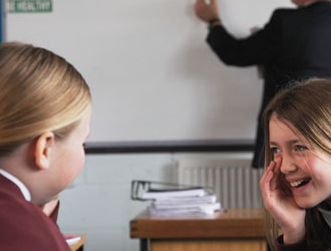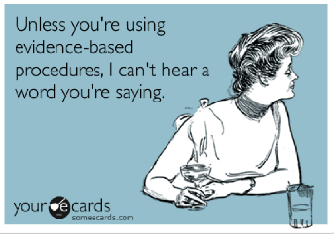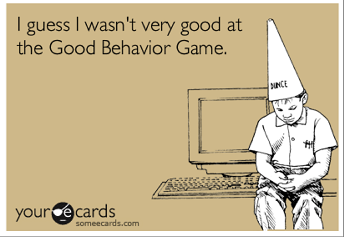Stop Talking! 25 Tips for Quieting (individual) Talkative Students.
"Shallow streams babble. Quiet waters run deep." Chinese saying
*Tips on quieting the entire class can be found at: http://www.behavioradvisor.com/NoisyClassroom.html
Aughh!! That incessant chatter… despite your pleas, warnings, and consequences. That burr-under-the-saddle, distracting verbal behavior interferes with our concentration, thus detracting from our instructional pace. It also detracts from the learning of that youngster and his/her classmates. We need to corral this off-task pesky behavior in order to create an optimal climate for teaching and learning.

Here you’ll find 25 tips (Yep, no wimpy platitude-filled “top ten” list here) for dealing with a single loquacious learner. They range from in–the-moment, low-key interventions to intensive high-impact behavior change strategies. Which one(s) you select will depend on a number of factors; the reason for the behavior, the quality of your relationship with the errant learner, and how ingrained and intervention-resistant the behavior has become, just to name a few.
Ready? Great! Let’s get going…
 Low-Key Interventions (Strategies that do not involve a reward system)
Low-Key Interventions (Strategies that do not involve a reward system)
- Provide a reminder to the target student of expectations as s/he enters the room.
- Have the student tell you the appropriate behavior that s/he will strive to demonstrate. (e.g., “I will be silent unless you recognize me to speak.”)
- Use positive phrasing. When correcting the youngster’s behavior, avoid telling him/her what NOT to do (e.g., “Stop talking.”). Instead, be certain to tell him/her WHAT TO DO (e.g. “Quiet please.”). Some students will need you to operationalize what is meant by “Quiet” (“Lips sealed together.”)
- Never talk over noise in your classroom. Devise signals (e.g., a silent five finger count down, “the teacher stare”, or other routine) designed to silence a noisy group/student.
- During a noisy time, softly say “If you can hear me, raise your hand.” The handraising of those near you gains the attention of others who then become silent. Continue with another low volume direction (e.g., “If you can hear me, touch your nose.”)
- If the student is unaware that s/he is exhibiting this inappropriate behavior, meet with him/her to describe what is occurring and which actions should be demonstrated.
- During a meeting over snack and drink, devise a “secret signal” system. Agree upon a signal given by you that indicates “Silence please.”, and a signal from the student that indicates “OK”.
- In that private meeting (see the previous tips) in which you discuss productive, academic verbal contributions that contribute to the lesson, versus disruptive, off-task behavior, role play situations involving the “secret signals”, and practice handraising if that action is desired.
- Use non-verbal signals accompanied by a facial look that is pleasant. (e.g., Finger to the lips, using the thumb and pointer finger to press your lips together, tapping your pointer finger on your ear multiple times, or other mutually known symbol)
- Use a non-verbal signal (OK sign, thumbs up, etc.) to indicate your pleasure when the student is quiet and engaged in the task at hand. Remain alert so that you are proficient in recognizing the quiet and studious behavior you wish to promote.
- At the end of an activity or class session during which the student performed better than is usual, be sure to verbally praise that withholding of talkative interaction.
- Provide the youngster with a copy of “The survival guide for kids with behavior challenges”.
- Change the seating arrangement, thus distancing the student from fellow learners who might also engage in conversation.
- Provide opportunities for the target student to speak appropriately during the class session. (e.g., read a passage, present a prepared answer practiced with you earlier, taking attendance)
Moderate Intensity Interventions (Strategies involving positive reinforcement or mild consequences) 
- Make a game of staying quiet. Determine a time interval during which the youngster has a strong likelihood of successfully staying quiet. Reward him/her with a point (toward the 5 to 50 needed to earn a desired prize or privilege) for each interval of quiet. With success, raise the number of points needed to earn a prize.
- Set a timer to sound at random times. Award points toward a privilege whenever the tone sounds and the class is engaged and attentive. Find out more at Momentary Time Sampling (coming soon on BehaviorAdvisor. Get on the B-list in order to receive the announcement).
- Hold a whole or partial class discussion at the beginning of the class session. Assure that the discussion is structured (i.e., Topic provided the day before, time limit observed, only handraisers recognized). At the discussion end time, students are informed that verbalizations for the rest of the period must be on topic and voiced only after one’s raised hand is recognized by the teacher.
- For the strategy above, have the target student provide the reminder regarding verbalizations.
- Designate a certain number of minutes during your class period with which you would be satisfied if all students were alert and appropriate (e.g., 47 of 55 minutes). Offer points toward a class privilege or prize once the required time period accumulates on a stop watch. Run the timer when students are fully engaged. Stop the watch when noise/talking is distracting. At the end of the required accumulated time, the students have earned “talk time”. This method would place peer pressure on talkative students to cease their verbalizations.
- Devise an individualized version of the above tip. Have the target student and a friend earn “talking time” whenever s/he has been attentive and quiet for a certain span of time. (e.g., 5 minutes to talk with friend after 50 minutes of accumulated quiet time on a stop watch)… but be prepared to defend this choice when others ask why they don’t have the same deal. (This strategy might be best for self-contained special needs classes.)

High Intensity Interventions (Programmed strategies with research evidence of effectiveness)
- Devise a contract with rewards for success, and (perhaps) penalties for failure.
- Use “Differential reinforcement of lower rates of behavior” (DRL). Record the number of talk incidents over a couple of days. Compute the average. Reward the target learner for staying under that average. Reduce the number allowed as the student develops greater ability to stay quiet.
- Have the target student self-record (coming soon) his/her off-task verbalizations using one of the common data recording (coming soon) formats.
- Implement an escalating penalty system for repeated episodes of whispering/talking
- Implement research proven, whole class “Good Behavior Game”, being aware of solutions when individual students fail to cooperate with this whole-class team oriented competition.

"The problem with talking too fast is you might say something you haven't thought of yet." Ann Landers.




 Low-Key Interventions (Strategies that do not involve a reward system)
Low-Key Interventions (Strategies that do not involve a reward system) 

